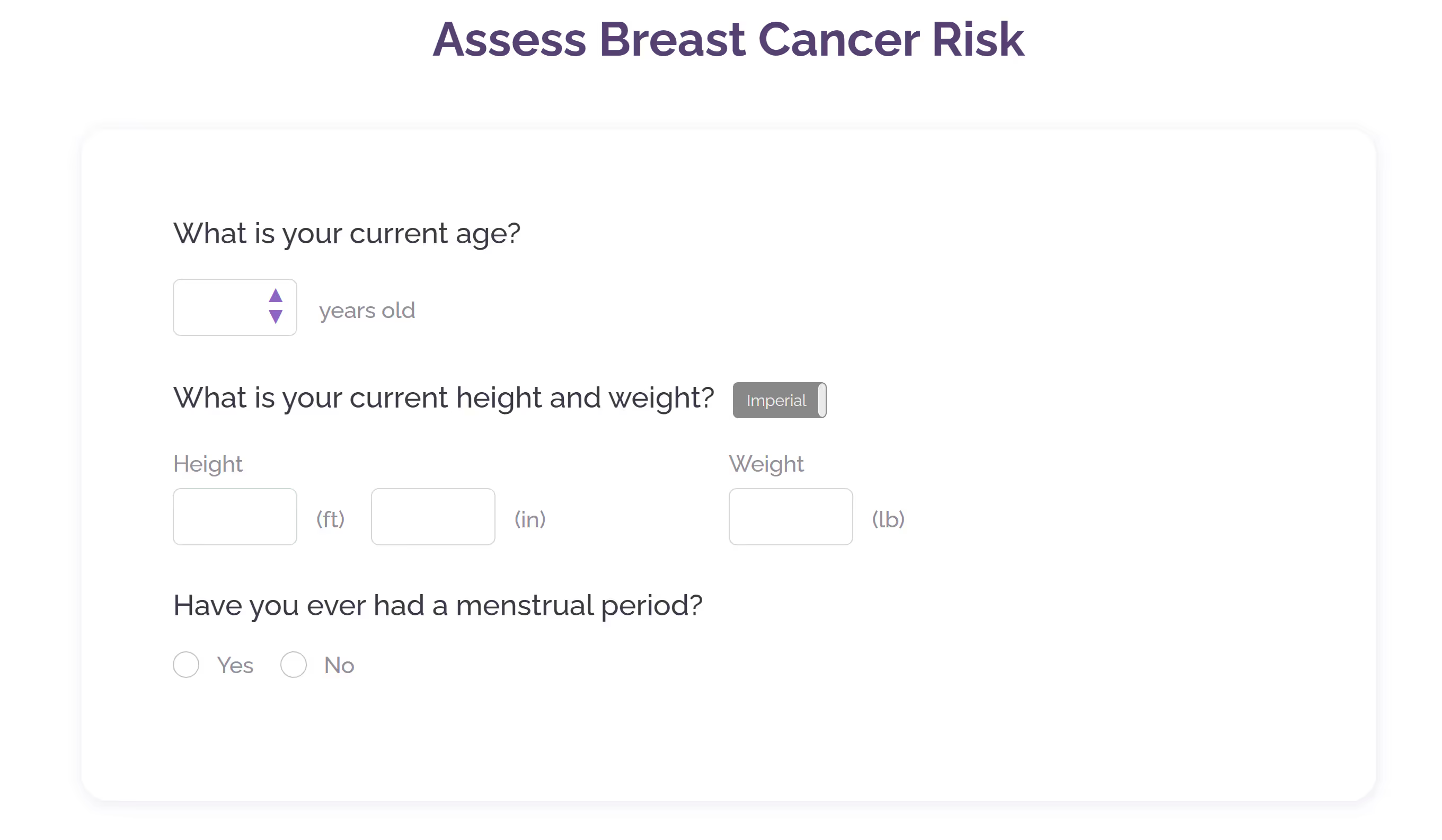Tyrer Cuzick Model Australia, Book Your Breast Cancer Test Today
Tyrer Cuzick model supports breast cancer risk assessment by identifying key risk factors, helping individuals & doctors create early intervention strategies.

Breast cancer remains a significant health concern worldwide. Early detection and personalised risk assessments are crucial in improving outcomes. One of the most recognised tools for evaluating an individual’s risk of developing breast cancer is the Tyrer-Cuzick model, also known as the IBIS Breast Cancer Risk Evaluation Tool. Whether you're exploring the Tyrer Cuzick test in Australia or seeking a detailed Tyrer Cuzick test assessment, understanding how this model works is key. This blog delves into the intricacies of the Tyrer-Cuzick model, its components, applications, and how it integrates into proactive healthcare systems like Everlab.
The Tyrer-Cuzick model is a statistical tool designed to estimate a woman’s risk of developing breast cancer over a specific period, typically 10 years, and throughout her lifetime. It incorporates a wide range of factors, including personal medical history, family history, and hormonal influences, to provide a comprehensive Tyrer-Cuzick risk assessment score.
The importance of tools like the Tyrer-Cuzick model lies in their ability to shift the focus from reactive to preventative care. Early detection not only increases survival rates but also reduces the need for aggressive treatments, which can have significant physical and emotional impacts.
The Tyrer-Cuzick model is one of several tools available for assessing breast cancer risk. Other options include:
The choice of tool depends on individual circumstances, with the Tyrer-Cuzick score calculator often preferred for its detailed, multifactorial approach.
Among the available breast cancer risk assessment tools, the Tyrer-Cuzick model is widely regarded as one of the most comprehensive—and for good reason. It includes a broader set of risk factors than many other models, offering a more accurate and personalised risk score.
One of its key advantages is that it considers breast density, a critical risk factor also used by the BCSC (Breast Cancer Surveillance Consortium) model. Women with dense breast tissue face a higher risk not only because density is associated with increased cancer risk but also because it can obscure tumours on imaging.
The Tyrer-Cuzick model also digs deeper into family history, including not just first-degree relatives, but also second-degree relatives and even cases of male breast cancer—a feature that sets it apart from simpler models. This extended view allows for better identification of hereditary risk patterns.
It further incorporates genetic factors like BRCA1 and BRCA2 mutations, which significantly increase lifetime risk. This makes the model particularly valuable for women considering genetic counselling or testing.
Finally, it accounts for detailed reproductive history, including age at menarche, age at first childbirth, and age at menopause—all of which influence hormonal exposure and long-term cancer risk.
With this level of detail, the Tyrer-Cuzick model offers one of the most precise assessments available, making it the go-to tool for clinicians and women wanting to make confident, informed decisions about their breast health.
While the Tyrer-Cuzick model doesn’t directly factor in environmental exposures or lifestyle habits, these elements are increasingly recognised as contributors to breast cancer risk. For example, exposure to endocrine-disrupting chemicals (EDCs) found in plastics and personal care products may impact hormonal balance. Similarly, smoking and a high-fat diet have been linked to higher risk levels. Addressing these factors through conscious lifestyle choices can complement the insights gained from the Tyrer Cuzick risk assessment calculator.
Breast cancer risk isn’t determined by a single factor but rather a combination of genetic, environmental, and hormonal influences. For instance, a woman with no family history of breast cancer but a history of atypical hyperplasia on a biopsy may have a risk similar to someone with a genetic predisposition. This underscores the importance of comprehensive tools like the Tyrer-Cuzick score calculator to integrate various elements into a cohesive risk score.

The calculator requires detailed input about the individual’s medical and family history. By analysing this data, it provides two primary risk estimates for invasive breast cancer:
The Tyrer-Cuzick test outputs both short-term and long-term risk levels based on your profile. These risk estimates assist healthcare providers in making informed decisions about screening and preventive strategies.

If your Tyrer-Cuzick score places you in a moderate or high-risk category, consider discussing these proactive steps with your healthcare provider:
These actions, guided by your healthcare team, can significantly reduce your risk and provide peace of mind.
The Tyrer-Cuzick model is considered one of the most accurate tools available for breast cancer risk assessment, particularly for women with complex risk profiles. Its strength lies in the depth of data it includes—from family history and genetics to hormonal and reproductive factors—allowing it to generate a highly individualised risk score.
Research has shown that the Tyrer-Cuzick model is especially effective at identifying women at moderate to high risk of developing breast cancer. It is more comprehensive than many other models because it incorporates BRCA1/2 mutations, breast density, and detailed reproductive history, making it particularly useful for personalised screening and prevention strategies.
However, like all models, it’s not perfect. Its accuracy depends on the quality of the data entered—if personal or family medical history is incomplete or incorrect, the risk estimates may be less reliable. Additionally, while it performs well across many populations, it may be less accurate for women of non-European ancestry due to limited validation data in those groups.
Still, when used alongside clinical judgment and other diagnostic tools, the Tyrer-Cuzick risk assessment calculator remains one of the most reliable methods for guiding breast cancer screening and early intervention decisions.
Here are some common methods used to screen for and monitor breast cancer:
The Tyrer-Cuzick risk assessment calculator can help identify if enhanced screening is needed.
Innovations in breast cancer screening are transforming early detection efforts. AI-driven tools now assist radiologists in analysing mammograms, often detecting subtle changes missed by human eyes. Additionally, liquid biopsies—a blood test detecting cancer-specific DNA—are emerging as a non-invasive screening method, although studies have shown that in current use, liquid biopsies based on cell-free DNA have a low sensitivity for early-stage breast cancer. While these technologies are still in early phases of development and are not currently part of routine care.

While some risk factors for breast cancer cannot be changed, there are several strategies that can help reduce a woman’s risk. Here are some practical steps to lower the risk of developing breast cancer:
By adopting these strategies, women can take proactive steps to lower their risk of developing breast cancer and improve their overall health.
Certain foods and dietary patterns may help lower breast cancer risk. Diets rich in fruits, vegetables, whole grains, and healthy fats, like those in olive oil and fish, are associated with lower risk levels. Conversely, diets high in processed foods, sugar, and red meat may increase risk. Incorporating anti-inflammatory foods such as turmeric, leafy greens, and nuts can also support overall health.
Chronic stress can affect hormone levels, potentially influencing breast cancer risk. While stress isn’t a direct cause, managing mental health through mindfulness practices, yoga, or counselling can help maintain hormonal balance and support general well-being.
While the Tyrer-Cuzick model is a valuable tool, it has certain limitations:
It's essential to use this tool as part of a broader risk assessment strategy.
The Tyrer-Cuzick test serves as a useful tool in breast cancer risk assessment. By understanding its functionalities and limitations, individuals and healthcare providers can collaborate to develop effective, personalised prevention and monitoring strategies. At Everlab, we use advanced diagnostics and personalised interventions to detect, prevent, and manage diseases like cancer, heart disease, diabetes and more.
The score shows your risk of developing breast cancer over 10 years and your lifetime. Under 15% is average, 15–19% is moderate, and 20%+ is high risk.
A normal or average Tyrer-Cuzick score is a lifetime risk below 15%.
A Gail score of 1.67% or higher over five years is considered high risk, especially for women over 35.
Breast density is assessed via mammogram and categorised into four levels: almost entirely fatty, scattered, heterogeneously dense, or extremely dense.
1. MagView – Understanding the Tyrer-Cuzick Score and Risk Model for Breast Cancer Assessment
https://magview.com/blog/why-tyrer-cuzick-is-the-breast-cancer-risk-model-of-choice
2. Medical News Today – What to know about the Tyrer-Cuzick score
https://www.medicalnewstoday.com/articles/tyrer-cuzick-score
3. IBIS Breast Cancer Risk Evaluation Tool – Official Tyrer-Cuzick Model Website
https://ibis.ikonopedia.com
4. Cancer Australia – Familial Risk Assessment FRA-BOC
5. National Cancer Institute – Breast Cancer Risk Assessment Tool (Gail Model)
https://bcrisktool.cancer.gov




Join 1000's of Australians improving their health with proactive, personalised healthcare.